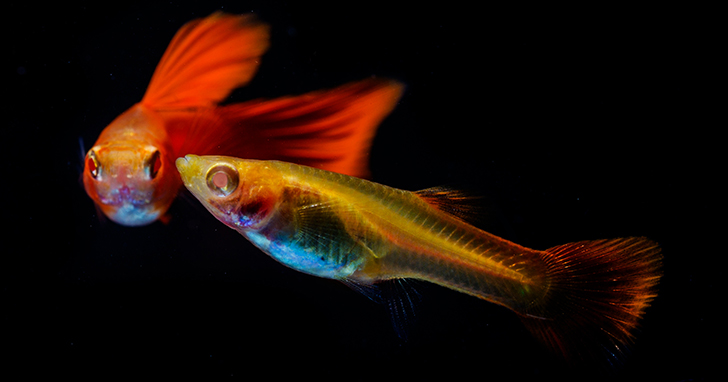
An Introduction to Livebearing FishWhat are livebearers?
These extremely colorful and active fish are popular among hobbyists of all experience levels. Despite their delicate appearance they are hardy, easy-care fish that add great beauty to any home or office aquarium. Just as their name suggests, livebearers are fish that give birth to live, free-swimming young. However, in the aquarium hobby, the term livebearer is commonly used to refer to a specific group of fish belonging to the family Poeciliidae. This group of freshwater fish includes perennial aquarium favorites such as mollies, guppies, and platies. Quick Stats:
Livebearers are able to thrive in a variety of water conditions and do well in planted aquariums. Though peaceful in temperament, it is a good idea to keep several pairs of the same species to eliminate any potential aggression that may occur. Livebearers are omnivores and require both algae-based foods as well as meaty foods. A varied diet including algae-based flake food, along with freeze-dried bloodworms, tubifex worms, and brine shrimp will provide proper nutrition to a wide range of different livebearer species. How long do livebearers live?
With an average life expectancy between 5 and 7 years, livebearers are relatively long-lived. This allows most hobbyists to witness the birth of several generations of fry. In fact, one of the most fascinating aspects of keeping livebearers is the rearing of young fry. Hobbyists of all ages will be immediately enthralled and discover a new joy to fish keeping. Livebearers provide depth and dimension to fish keeping, provide a fantastic learning experience for both children and adults, and nurture a life-long appreciation for the aquarium hobby. How are livebearers born?
For most hobbyists, their first experience with fry (baby fish) is often through livebearers. Without any effort on your part, you may discover that the livebearers you brought home have given birth to a small brood. Depending on water conditions, temperature, and diet, some livebearers can have broods as often as every four to eight weeks. You can tell if a female is ready to give birth by her enlarged abdomen or a dark spot located near her anal fin. The spot will turn darker as her delivery date nears. But you must be watchful because some fish will eagerly feast on the newly hatched fry. To prevent this from happening, place the pregnant female in a separate 5-to-20-gallon breeding tank just before she releases the fry. This nursery should have all the features of a regular aquarium including filtration (simple foam filters are a great choice), a heater, and some artificial plants for cover. Float the plants, as babies will hide at the surface when first born. Substrate is not necessary and having no substrate makes it easier to see and remove uneaten food. After the pregnant female has released all of her fry remove the female and return her to the main display aquarium. How do you raise fry in an aquarium?
The fry should be fed a quality food, such as baby brine shrimp, baby fish food, or quality flake food ground into a fine powder. Feed the fry small amounts several times a day. Maintain good water quality by performing regular water changes. Using water from your established aquarium is a great way to acclimate the fry to water conditions of their future home. In about 4 to 6 weeks, the babies should be large enough to release into the main aquarium. But be sure the babies have grown larger than the mouths of adult fish. If it's not possible to set up a separate aquarium, drop-in breeders are a great alternative. Keep in mind that the babies will quickly outgrow and crowd the net breeder. The fry will need to be moved to a larger aquarium sooner to ensure proper growth. Question :
What are the benefits of livebearers? Anwser :
Livebearers are the perfect fish for beginners and longtime hobbyists. They are peaceful, beautiful, hardy, and can adjust to a variety of water conditions. The dark spot at the back of the abdomen is actually the eyes of all the babies as they become ready for birth. Pre-birth behavior can include rubbing the bottom of the abdomen back and forth on the top of a leaf or swimming within dense plants at the top of the aquarium. An isolation breeder can accommodate up to two pregnant females and provides safe haven for the fry after birth. Slits in the sides and top enable the babies to escape the main compartment containing the mother and swim safely at the top or bottom. The transparent breeder lets you watch the birth process, which can take several hours. Newborn fry should be kept in a net breeder or a small tank of their own until they are large enough to fend for themselves. Strong and smart fry born loose in the general population of your aquarium will find a place to hide if you float dense plant cuttings in a corner and anchor them to the top of a heater, thermometer, or filter. Place a sponge pre-filter over the filter intake to prevent fry from being sucked up. Juveniles guard small fry from hungry adults. Related Articles
|
|
|




